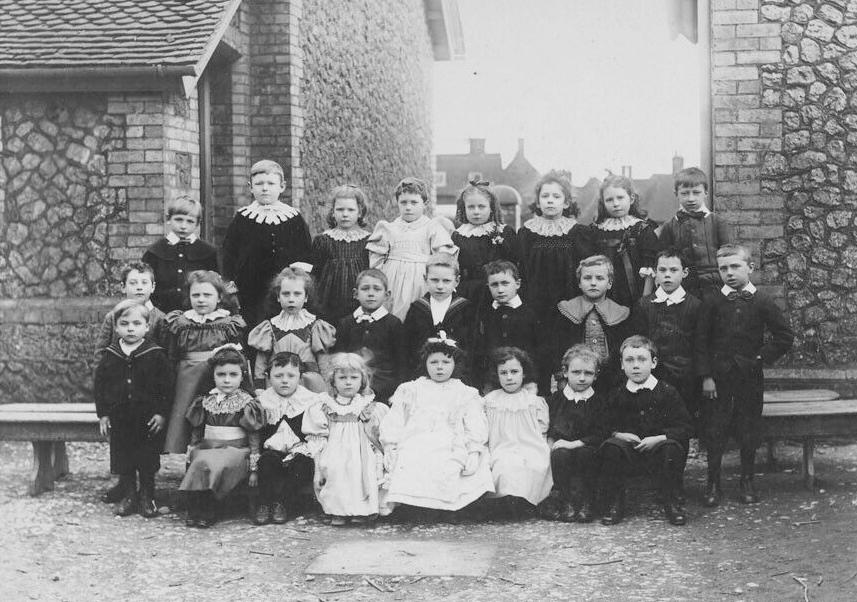
English 1890s School Trends: Types of Schools--Levels

Figure 1.--This cabinet card shows a pre-school school we believe in Ashforth, Kent. The children are clearly below primary age (6 years), but even though a small group the are different ages. We would guess 3-5 years old. The boys mostly have Eton collars, but we see Fauntleroy and sailor suits as well. The girls wear a range of fancy dresses and lace collars. The portrait is undated, but the puff sleeves help to date it to the 1890s. Surprisingkly there are no pinafores. The parents may have told the chikdren to dress up. The studio was Alaric Hawkins De'ath in Ashford.
|
|
We notice three basic levels of schools in England. There were pre-peimary schools like kindrgartens. It is not alwats clear just what kind od school we are looking at. Some of the available images of these pre-schhols show children of the same age and others show a range of pre-school ages. Abd we are not sure who was sponsoring them. We know that the churches played a major role in these schools.
The largest level was the primary schools. This state schools were a primary school system which began with 6-tear olds. They provided an 8-year program for children to about 13 years of age. This is 2 years beyond what is considered secondary school age in most modern systems. The great bulk of English children attended the state schools. There were private primary schools. Actually they followed the state arrangement of teaching to children through age 13 years. These were the preparatory schools which fed children into the public schools. Most were natding schools in the 1890s which of course prepared them for the boarding school program of the pubklic schools. The prep schools had a little older statring age than the primary schools in part because boarding was not seen as appropriate for most children. Actual rules varied from school to school, but most children began around agge 8 years.
While school reforms made important changes in primary education, the secondary schools were left largely untouched. And most British children ended their education when they finished primary school. It should be stressed that this was also the case in other countries. Most children did not gomon to secondary schools. There were of course seondary schools. The private schools were the public schools which werre boarding schols. The grammar schools were also fee paying schools, but with lower fees than the public schools, although they emulated the public schoolm, program on a day school basis. They received some state support. .
HBC-SU

Related Chronolgy Pages in the Boys' Historical Web Site
[Main Chronology Page]
[The 1880s]
[The 1930s]
[The 1940s]
[The 1950s]
[The 1960s]
[The 1970s]
[The 1980s]
Related Style Pages in the Boys' Historical Web Site
[Return to the Main English school 1890s chronological page]
[Return to the Main English school 1890s chronological page]
[Return to the Main English school late-19th century chronological page]
[Return to the Main English school chronological page]
[Return to the Main school page]
[Long pants suits]
[Short pants suits]
[Socks]
[Eton suits]
[Jacket and trousers]
[Blazer
[School sandals]
Navigate the Boys' Historical Clothing School Uniform Pages
[Return to the Main School Country Pages ]
[Australia]
[England]
[France]
[Germany]
[Italy]
[Japan]
[New Zealand]
[Scotland]
[United States]
Navigate the HBC School Section
[Activities]
[Chronology]
[Clothing styles]
[Countries]
[Debate]
[Economics]
[Garment]
[Gender]
[Hair]
[History]
[Home trends]
[Literary characters]
[School types]
[Significance]
[Transport and travel
[Uniform regulations]
[Year level]
[Other topics]
[Images]
[Links]
[Registration]
[Tools]
[Return to the Historic Boys' School Home]
Created: 10:56 AM 11/5/2019
Last updated: 10:56 AM 11/5/2019




